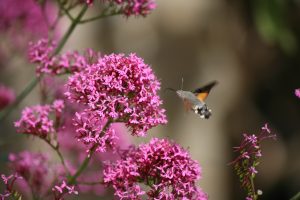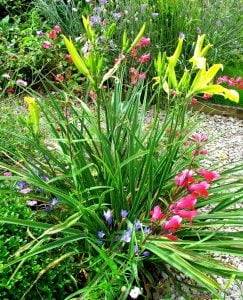It’s August and I feel as if I’m losing the battle. The plants definitely seem to have won this year, so I’m pulling out and cutting back lots of things that I don’t want to self seed quite as much as they did last year! I’m aiming to leave about 20% in situ for next year and consigning the rest to the green bin. It has to be the green bin, because if they get in to the compost heap I shall have a garden covered in thugs such as meadow cranesbill (Geranium pratense), sweet rocket (Hesperis matronalis), Valerian (Centranthus ruber) and mixed astrantia seedlings. The Best Beloved and I have already had words, because one barrow load ended up in the compost!
Cutting out lots of seedpods not only prevents too many seedlings, it helps to keep the borders looking summery too. And I’m also eradicating early touches of brown that hint that autumn is on the horizon (which it is) so any crisped foliage of heucheras or Japanese anemones is being carefully snipped out. The blast of hot weather in the third week of July has wreaked a bit of havoc, but generally my plants welcomed the sun after weeks of grey, windy weather and cold, heavy squalls. I long for a night of real summer rain because the garden’s dry and wind battered. Who knows, my carrots any even germinate!
I wouldn’t be without my self seeders though, because generally they are pollinator pleasers that produce lots of nectar in their quest to set lots of seeds. Valerian or Centranthus ruber, which has looked much weedier than usual this year, is adored by butterflies and moths because each flower has an inch-long tube. This makes it perfect for long curly tongues, but shorter tongued bees find it difficult to get at the nectar. I grow pink and white valerian, but have failed with the deep-red. I also grow a lilac-pink valerian from Morocco, C. lecoqii, and this has proved hardy here despite its North African roots. Deadheaded, all valerians will carry on flowering from lower shoots from April until late. A late July shearing, back to the stumps, gets a late flush of flower and helps keep your plants bushier and able to survive winter.

Valerian’s the star attraction for the Humming-bird hawk-moth and in good years we get several and we identify them from the variable black and white checked patterns on at the end of the thorax. Ours get individual names, well we don’t get out much. They have a tendency to flit by in time for afternoon tea so they provide extra entertainment in dull lives. This year has not been good for them so far, but we often see them right up until late October so there’s plenty of time yet. We have two of their food plants in our small meadow, Lady’s bedstraw (Galium verum), and Hedge Bedstraw (Galium album) and they do lay eggs on Valerian (Centranthus ruber). At the moment small tortoiseshell butterflies and meadow browns are visiting in the pleasanter spells, which have been a bit few and far between this summer.
Once pollinated valerian produces small fluffy, flyaway seeds so seedlings pop up although I do try to restrict it to the garden gate, the front of the cottage and the stone seat in the middle of the summer borders. This Mediterranean plant is good at self seeding in warm places and has become an invasive alien in the Western Cape of South Africa. Valerian is a perennial, but like many lavish self seeders, it tends to burn itself out after about four years or so. So some must always be allowed to set seed.
One of the things I’ve noticed about valerian is the way the scent changes according to the weather. It’s fairly pleasant on a nice sunny day, when butterflies abound, but on a dull damp day it will smell of dog muck – sorry there was no way to dress that up – and this attracts flies still out and about on cool weather. Lots of plants change scent according to the weather and when collecting elderflower heads, to make cordial, it’s important to pick them when they don’t smell of cat urine – or you’ll be drinking it later. They must smell fresh and summery.
I use a lot of umbels in the garden and some are annuals and biennials, but I’m far more careful with these for the seeds are really precious. As soon as they are ripe I plant them, either in seed trays or straight into the garden. I’ve already planted some Orlaya grandiflora, the white lace flower and a woodlander with acid-yellow flowers- Smyrnium perfoliatum. Any Ammi seeds are also sown now. All umbellifers go much better sown as soon as the seeds ripen and they make better plants if they can germinate in the autumn.
Umbellifers are diverse and many gardeners do not realise that astrantias (Hattie’s pincushion) are umbellifers because their tiny flowers are not in airy umbels. I favour sterile astrantias, like the candy-pink ‘Roma’, because self-seeding is such a problem as the flowers brown.
Eryngiums (sea hollies) are also umbellifers and the most architectural is the biennial Miss Willmott’s ghost or Eryngium giganteum. This is prickly and steely, with large thimbles that attract many different bees and wasps. In late August the heads will brown and most have to be removed here, because a few seedlings go a long way.
Others annuals left to self-seed on their own, with varying degrees of success. I had a wonderful stand of double white opium poppy last year – but not a sniff this year. Opium poppies, like all annual poppies, set hundreds of seeds but deadheading them doesn’t produce more flowers so just tug most of them up. Other annuals (such as pot marigolds or calendulas, blue cornflowers, African marigolds and antirrhinums) respond well to deadheading and keep on flowering.

The great thing about a laissez-faire approach to plants setting themselves about on their own is the way they surprise you. I grow a blue bulb on the sunny summer border edges, now called Tritelia laxa ‘Koningin Fabiola’, but once known as brodiaea. It’s mainly sold under this name and not tritelia. It’s a deep-blue, lax bulb about a foot high and commonly called Californian hyacinth. It adores full sun and is always glorious in July, flowering without any foliage. By mid-August it’s browned into a seed head so it’s tugged out gently. It’s as cheap as chips to buy (try Peter Nyssen ) and somehow this puts gardeners off.
It grows fairy near a classy, pallid-yellow hemerocallis called ‘Whichford’ which I really rate because the base of the foliage is almost purple. However one brodiaea has placed itself near another yellow hemerocallis with spidery flowers in an entirely different part of the garden, close to a box ball. This one lone head, a bolt of blue as rich as the Aegean sea, has brightened the whole area. It shows that you shouldn’t be too strict in the garden, or in life. A bit of slack and serendipity can have the most surprising results?



